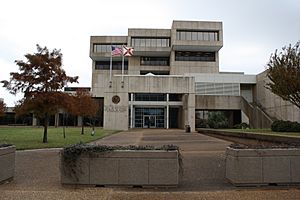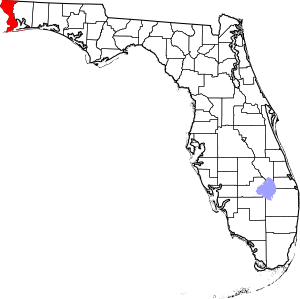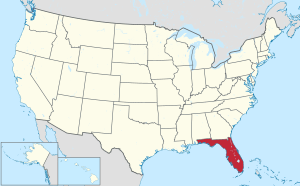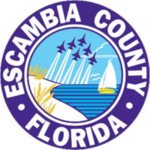Escambia County, Florida facts for kids
Quick facts for kids
Escambia County
|
||
|---|---|---|

Escambia County Courthouse
|
||
|
||

Location within the U.S. state of Florida
|
||
 Florida's location within the U.S. |
||
| Country | ||
| State | ||
| Founded | July 21, 1821 | |
| Named for | Escambia River | |
| Seat | Pensacola | |
| Largest city | Pensacola | |
| Area | ||
| • Total | 875 sq mi (2,270 km2) | |
| • Land | 656 sq mi (1,700 km2) | |
| • Water | 218 sq mi (560 km2) 25.0%% | |
| Population
(2020)
|
||
| • Total | 321,905 | |
| • Density | 485/sq mi (187/km2) | |
| Time zone | UTC−6 (Central) | |
| • Summer (DST) | UTC−5 (CDT) | |
| Congressional district | 1st | |
| Website | http://myescambia.com | |
Escambia County is the westernmost and oldest county in the U.S. state of Florida. It is in the state's northwestern corner. At the 2020 census, the population was 321,905. Its county seat and largest city is Pensacola. Escambia County is included within the Pensacola-Ferry Pass-Brent, Florida, Metropolitan Statistical Area. The county population has continued to increase as the suburbs of Pensacola have developed.
Contents
History
The area had been inhabited for thousands of years by indigenous peoples of varying cultures. Historic American Indian tribes at the time of European-American settlement were the Pensacola and Creek.
Escambia County was organized by European-Americans on July 21, 1821, after the United States bought East Florida and West Florida from Spain. It was named for the Escambia River. The name "Escambia" may have been derived from the Creek name Shambia, meaning "clearwater", or the Choctaw word for "cane-brake" or "reed-brake".
Created on the same date, Escambia and St. Johns counties were Florida's two original counties, covering the entire territory within modern state boundaries. The Suwannee River was the border between them, which follows a winding path from the northern border of the state to the Gulf of Mexico. Essentially, the Escambia county government had jurisdiction over the "panhandle" and "big bend" areas and St. Johns over the remainder of the entire state.
As population increased in the frontier territory, 21 counties were later organized from Escambia county directly or indirectly. They include Jackson (1821), Gadsden (created from Jackson)(1823), Leon (1824), Walton (1824), Washington (created from Jackson and Walton)(1825), Hamilton (1827), Jefferson (1827), Madison (created from Jefferson) (1827), Franklin (1832), Calhoun (1838), Santa Rosa (1842), Wakulla (created from Leon) (1843), Holmes (created from Jackson and Walton) (1848), Liberty (created from Gadsden) (1855), Lafayette and Taylor (created from Madison) (1856), Bay (created from Washington) (1913), Okaloosa (created from Santa Rosa and Walton) (1915), Dixie (created from Lafayette) (1921), and Gulf (created from Calhoun) (1925). The total number of counties in Florida in 2013 is 67.
Geography
According to the U.S. Census Bureau, the county has a total area of 875 square miles (2,270 km2), of which 656 square miles (1,700 km2) is land and 218 square miles (560 km2) (25.0%) is water.
The county jurisdiction includes the island of Santa Rosa south of Pensacola; it is not part of Santa Rosa County proper. Escambia County is part of the Pensacola-Ferry Pass-Brent Metropolitan Statistical Area.
Adjacent counties
- Escambia County, Alabama — north
- Santa Rosa County, Florida — east
- Baldwin County, Alabama — west
Escambia County in Florida and Escambia County in Alabama are two of 22 counties or parishes in the United States with the same name to border each other across state lines.
National protected areas
Demographics
| Historical population | |||
|---|---|---|---|
| Census | Pop. | %± | |
| 1830 | 3,386 | — | |
| 1840 | 3,993 | 17.9% | |
| 1850 | 4,351 | 9.0% | |
| 1860 | 5,768 | 32.6% | |
| 1870 | 7,817 | 35.5% | |
| 1880 | 12,156 | 55.5% | |
| 1890 | 20,188 | 66.1% | |
| 1900 | 28,313 | 40.2% | |
| 1910 | 38,029 | 34.3% | |
| 1920 | 49,386 | 29.9% | |
| 1930 | 53,594 | 8.5% | |
| 1940 | 74,667 | 39.3% | |
| 1950 | 112,706 | 50.9% | |
| 1960 | 173,829 | 54.2% | |
| 1970 | 205,334 | 18.1% | |
| 1980 | 233,794 | 13.9% | |
| 1990 | 262,798 | 12.4% | |
| 2000 | 294,410 | 12.0% | |
| 2010 | 297,619 | 1.1% | |
| 2020 | 321,905 | 8.2% | |
| U.S. Decennial Census 1790-1960 1900-1990 1990-2000 2010-2020 2020 |
|||
2010 Census
At the 2010 census there were 297,619 people, 116,238 households, and 74,040 families living in the county. The population density was 449 people per square mile (174/km2). There were 136,703 housing units at an average density of 206 per square mile (80/km2). The racial makeup of the county was 68.9% White, 22.9% Black or African American, 0.9% Native American, 2.7% Asian, 0.1% Pacific Islander, 1.3% from other races, and 3.2% from two or more races. 4.7% of the population were Hispanic or Latino of any race. Of the 116,238 households 25.5% had children under the age of 18 living with them, 42.5% were married couples living together, 4.8% had a male householder with no wife present, 16.3% had a female householder with no husband present, and 36.3% were non-families. 28.9% of households were one person and 10.2% were one person aged 65 or older. The average household size was 2.41 and the average family size was 2.96.
The age distribution was 21.6% under the age of 18, 13.0% from 18 to 24, 24.2% from 25 to 44, 26.8% from 45 to 64, and 14.4% 65 or older. The median age was 35 years. For every 100 females, there were 98.60 males. For every 100 females age 18 and over, there were 97.10 males.
The median household income was $43,707 and the median family income was $54,543. Males had a median income of $38,878 versus $30,868 for females. The per capita income for the county was $23,773. About 12.7% of families and 16.9% of the population were below the poverty line, including 26.4% of those under age 18 and 9.2% of those age 65 or over.
Transportation
Airports
- Coastal Airport
- Ferguson Airport
- Pensacola International Airport
Transit
Escambia County is served by buses run by Escambia County Area Transit.
Major highways

 I-10 / SR 8
I-10 / SR 8 I-110
I-110 US 29
US 29 US 90
US 90 US 98
US 98
 BUS US 98
BUS US 98 State Road 4
State Road 4 State Road 97
State Road 97 State Road 173
State Road 173 State Road 289
State Road 289 State Road 291
State Road 291 State Road 292
State Road 292 State Road 295
State Road 295 State Road 296
State Road 296
Railroads
Pensacola was a scheduled stop on the route of Amtrak's Los Angeles-Orlando Sunset Limited from 1993 to 2005, when damage to railroad bridges and tracks caused by Hurricane Katrina resulted in cancellation of the route east of New Orleans. Escambia County has had no passenger train service since then.
Before the creation of Amtrak in 1971, Pensacola was served by the New Orleans-Jacksonville Gulf Wind, operated jointly by the Louisville and Nashville Railroad and the Seaboard Air Line Railroad.
The following freight railroads serve Escambia County:
- CSX from Flomaton, Alabama, to Pensacola
- Florida Gulf & Atlantic Railroad, which acquired most of the CSX main line from Pensacola to Jacksonville on June 1, 2019
- Alabama & Gulf Coast Railway from Amory, Mississippi, to Pensacola
Library
Escambia County is served by the West Florida Regional Library System.
Communities

City
Town
Census-designated places
Other unincorporated communities
- Barrineau Park
- Barth
- Beulah
- Bluff Springs
- Bogia
- Bratt
- Brownsville
- Cantonment
- Innerarity Point
- McDavid
- Oak Grove
- Pensacola Beach
- Perdido Key
- Pleasant Grove
- Walnut Hill
Ghost towns
Education
Public primary and secondary education schools in Pensacola are administered by the Escambia County School District.
The University of West Florida, Pensacola State College, and Pensacola Christian College are located in Escambia County.
Images for kids
-
Juan Sebastian de Elcano, a Spanish tall ship, initiates a 21-gun salute in honor of the city of Pensacola's 450th anniversary in 2009.
See also
 In Spanish: Condado de Escambia (Florida) para niños
In Spanish: Condado de Escambia (Florida) para niños



